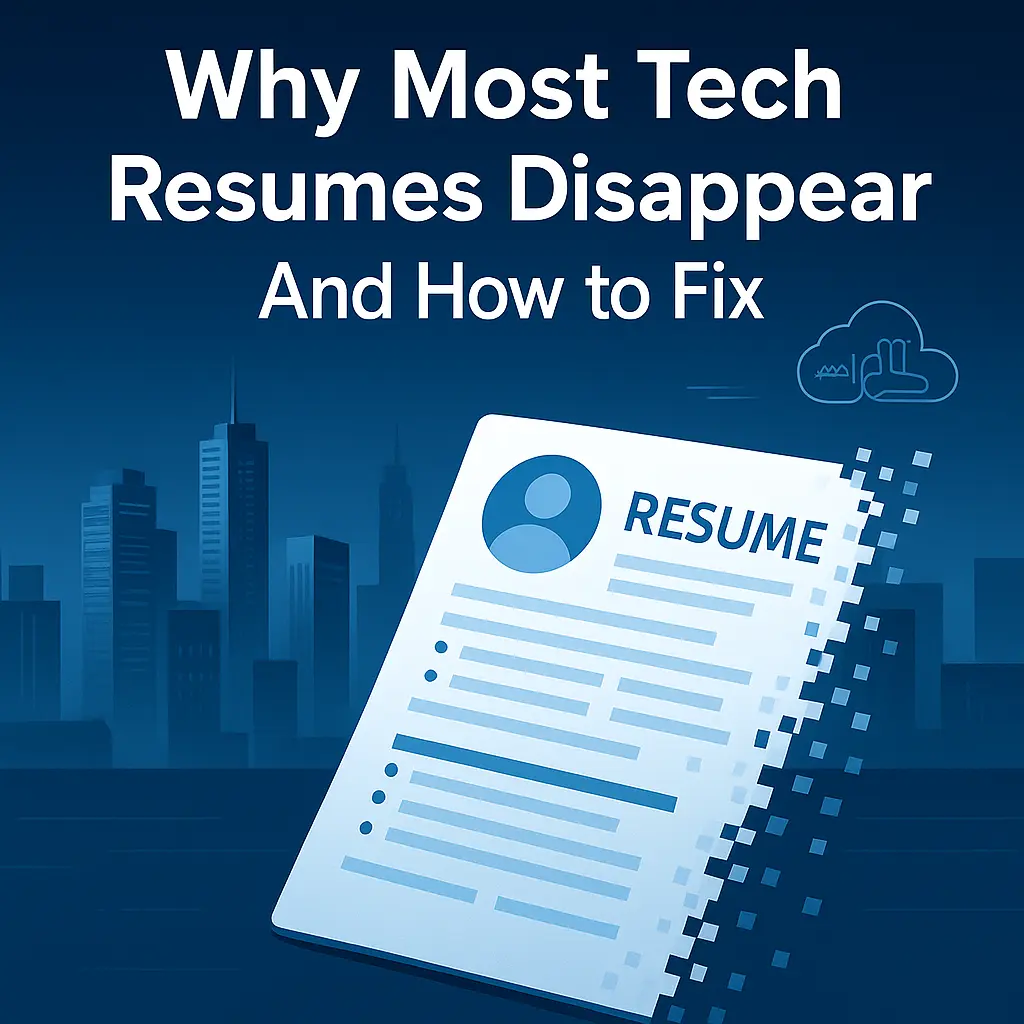Statistics show that there are more than 7 million people unemployed in mid 2025, in America alone, while there are plenty of open tech roles. Meanwhile, tech companies continue to post job openings in everything from cloud engineering to data science to cybersecurity.
So why aren’t these positions being filled? You’d think it would be easy to match one to the other, but it’s not.
Why is that?
And why most tech resumes disappear during application? How do you fix that?
Reality will hit you hard once you’re there. Most resumes never make it past the applicant tracking system (ATS) and seem to vanish into thin air.
No callback. No email. Not even a rejection. Just... nothing.
The tech job market in the US thriving. Companies are hiring. Budgets are approved. Teams need talent.
But the gap between job seekers and job openings isn’t just about skills. It’s the filtering system. The filtering system doesn’t just screen out unqualified candidates; it often eliminates highly capable ones whose resumes aren’t formatted or customized correctly.
That’s why great candidates are often left wondering why they never heard back.
It’s not that companies aren’t hiring. They are. The tech job market is growing, but so is the competition and the technology that stands between you and a human recruiter
This guide breaks down what causes good candidates to get filtered out and gives you steps that actually work. Learn how simple changes in your resume layout can help you stand out.
Find out how you can fix these mistakes and finally land more interview calls.
Read on if you're ready for a real shot at your next tech role!
Common Reasons Tech Resumes Get Rejected
Many resumes get filtered out early in the hiring process due to small mistakes. Artificial intelligence and applicant tracking systems now screen resumes stricter than ever.
Overloaded with irrelevant information
- Including too much irrelevant information can bury your best skills and slow down the hiring process. Copy-pasting job descriptions, for example, floods a resume with generic details instead of showing individual impact or achievements at previous companies.
- AI and ATS now filter resumes more strictly, making it even easier for staffing teams to reject unfocused applications.
- Vague statements like “responsible for various tasks” or listing unrelated projects, lack of customization often forces valuable keywords into the background while promoting non-essential content.
As one tech recruiter said,
“The quickest way to lose my attention is drowning out relevant skills with unnecessary details.”
📌 Wondering why you're getting rejected every time? The answers might surprise you. Why Am I Getting Rejected Every Time I Apply for Jobs?
Too generic and not tailored to the job description
Over 75 % of rejected resumes failed to match the job description’s keywords or skills. Tech employers expect candidates to align their experience and tools, like Python or AWS, with specific requirements from the posting.
Generic statements such as “strong problem-solving skills” do not prove direct value for the company or position.
Take that into consideration when writing your own resume.
Hiring managers want proof that you read and understood their needs. Recruiters are looking for specific contributions, tools you have used, and how you made an impact. If your resume sounds like hundreds of others, it will not stand out.
Customizing your content to reflect the job description shows attention and intent. This will always be your age in a highly competitive field such as tech because hiring teams notice relevant details quickly.
Lack of measurable achievements
Many tech resumes leave out quantifiable evidence of personal contributions. Vague statements like “improved system performance” do not show impact or value to hiring managers.
So, what was the outcome? What did you improve?
Tech companies want to see results backed by data, such as increased server speed by 25% using Kubernetes optimization.
This is a simple formula you can use: Accomplished X, as measured by Y, by doing Z.
Ok, how? Frame it like this.
For example:
Reduced cloud costs by 30% in three months through automation with Jenkins and GitHub Actions.
Sounds simple, but it's powerful when applied correctly. Metrics from analytics, performance dashboards, or cost-saving reports make a real difference and provides proof of your success while highlighting your technical skills in context.
This tip isn’t an open book, the ATS look for numbers and clear results when screening resumes for tech roles at companies such as Google or Microsoft, yes, FAANG/MAANG the big names in tech.
If you’re saying you improved something, show them how much. Pull metrics from the tools you already use, such as dashboards, analytics reports, or Jira tickets, and include them wherever it makes sense.
These could include system uptime, page load speed, latency reductions, cost savings, error rates, or even user growth.
So, how do you get in?
You prove your value. And you do it clearly, concisely, and confidently.
📌 Not showing your impact clearly? That might be killing your chances
The Silent Killer of Job Offers: Underselling Yourself on Resumes
Poor formatting and readability issues
Jumping from a lack of measurable achievements, another issue blocks many tech professionals: poor formatting and readability. Resumes with cluttered layouts or small fonts can confuse both human recruiters and Applicant Tracking Systems like Workday or Greenhouse.
ATS software often filters out resumes that use charts, tables, graphics, or unusual fonts because these elements disrupt the parsing process.
Remember, what looks good doesn’t necessarily equate to what performs well.
A visually impressive resume filled with icons, sidebars, or columns might look sleek to you, but it can break completely when scanned by an ATS. The software isn't designed to interpret graphics or creative layouts, it’s built to read clean, structured text.
So please, stop sabotaging your resume.
📌 That sleek template, photo, or generic design might look good but ATS will reject it. Find out why;
Why You Should Stop Using Free Resume Templates
Stop Using Fancy Resume Fonts: Avoid ATS Rejection
Don’t Add Photos on Your Resume the ATS Will Reject it
How to Identify if Your Tech Resume is the Problem
You’ve applied to countless jobs, waited weeks, and still haven’t heard back. At this point, you might be wondering if the problem is your resume.
Silence from the hiring team is one subtle signal.
So how can you tell if your resume is working against you?
If you’re still unsure whether your resume is holding you back, let us help you spot the signs. These red flags often mean it's time for a resume refresh.
On average, a recruiter spends just 6 to 7 seconds looking at each resume before deciding what to do next.
They want clear proof of your technical skills and results.
According to recruiters and tech hiring managers, it’s not just typos, outdated layout, generic summaries, missing links to GitHub projects or missing keywords that hurt your chances. It’s the subtle things most job seekers never consider.
Here’s what to watch out for:
- Your job titles don’t reflect your real level of responsibility
If your title says "Developer" but your tasks show senior-level ownership, they may assume you’re underselling yourself. On the flip side, inflated titles without proof make recruiters skeptical.
- You list tools, but not how you used them
Saying you used "Python" isn't enough. Hiring managers want to know how you used it. Were you automating scripts? Building APIs? Without context, your skills seem surface-level. - You sound like a doer, not a problem-solver
If your resume only shows what you were assigned, not what you improved or delivered, you’ll come across as passive. Hiring managers want proactive thinkers who take initiative, especially in tech. - Your resume shows movement but no growth
If you've had multiple roles but your responsibilities, tools, or impact stayed the same, it may look like you're stagnant, even if you were promoted or took on new challenges. Recruiters will look for signs of how you evolved.
- You mention projects, but don’t explain the outcome
Including too many projects, especially without results, makes your resume feel cluttered. Recruiters prefer a few high-impact examples that clearly demonstrate your value over a laundry list of side work. - Listing outdated tools shows you’re not well informed of current tech
Listing outdated tools without modern equivalents signals that your skills may not be up to date.
- Your bullet points lack focus or formatting
If yours has walls of text, inconsistent bullet points, or no clear hierarchy, they’ll move on quickly, even if the content is good.
- No sign of collaboration or cross-functional work
No man is an island, especially in tech, where you’re expected to work with different departments and teams. There’s no such thing as coding in a vacuum. If your resume makes it seem like you worked in isolation, hiring managers may assume you’ll struggle in a team environment. Show where you partnered across departments to solve problems, deliver features, or launch products. Teamwork is a core part of the job.
- You’re using the wrong type of resume for your career stage
Senior professionals using entry-level templates or junior candidates writing like executives is a recipe for confusion and rejection. Avoid creating mixed signals about your actual role skills and maturity in the field.
- Your LinkedIn doesn’t match your resume
A mismatch between your resume and online presence creates confusion. Recruiters will cross-check both. If your job titles, dates, or descriptions are inconsistent, it can be a red flag for credibility.
- Your resume doesn’t show how your work contributed to company goals
Show how your work improved performance, saved time or money, supported growth, or solved real user problems. Connecting your role to company goals proves that you understand impact, not just execution.
Most don’t realize these things until someone points them out.
A strong tech resume doesn’t just list what you’ve done. It tells a clear, focused story about your skills, growth, and the impact you’ve made. When you align your experience with what recruiters are actually looking for, you turn silence into callbacks and missed chances into interviews.
📌 Real offers come from real alignment. Here's how to make your resume work for you. The Resume That Gets You Real Job Offers
FAQs About Tech Resumes
Q: What is an ATS and how does it affect my tech job application?
An ATS or Applicant Tracking System filters resumes based on keywords and formatting. If your tech resume isn't optimized for ATS, it may never reach a recruiter, even if you meet all the qualifications.
Q: Should I customize my tech resume for every application?
Yes, customizing your tech resume for each job is essential. Using keywords from the job description improves your chances of passing ATS scans and getting noticed by recruiters.
Q: How can I highlight technical skills effectively on my resume?
Feature your technical skills in a dedicated section and show them in action through bullet points in your work experience. Use metrics to prove impact like improved performance or successful deployments.
Q: Do tech recruiters use AI to scan resumes?
Many tech companies use AI-powered ATS software to filter applications. That’s why formatting and keyword optimization matter. A human may never see your resume if the AI doesn't rank it high enough.
Q: What’s the fastest way to fix a disappearing resume?
Use an AI resume builder or reverse recruiter service that tailors your resume to each job. These tools autofill job applications and ensure your resume meets current ATS standards.
Q: Why does my resume keep getting ignored despite my experience?
Experience alone isn't enough if your resume lacks the right keywords or structure. An ATS might filter it out if it doesn’t match the job post closely enough or if the formatting is not machine-readable.
Q: How do I know if my resume is ATS-compliant?
Avoid using tables, graphics, or multiple columns. Stick to simple formatting and use exact phrases from the job description. You can test your resume with free ATS checkers or AI resume tools.
Q: What resume format works best for tech jobs?
A reverse-chronological format works best for tech roles. It highlights your most recent experience and career growth while keeping things clear for both ATS and human readers.
Q: Should I include all my tech skills even outdated ones?
Focus on current and relevant skills. Listing outdated technologies can make your resume feel less focused. Prioritize modern frameworks, languages, and tools mentioned in the job description.
Q: How do I optimize my resume for remote or hybrid tech roles?
Use keywords like remote collaboration, asynchronous work, and distributed teams. Mention remote tools like GitHub, Slack, or Zoom to show you're equipped for flexible work environments.
Final Thoughts: Resume Customization Fixes Disappearing Tech Resumes
Tech resumes often disappear for simple, fixable reasons. The truth is, even great candidates disappear in the hiring process because their resumes don’t do them justice.
If you’ve made it this far, one thing is clear: You care about getting it right.
You’re not just firing off random applications. You want your next role to be a real fit.
Now is the time to make sure your resume works as hard as you do.
Whether you’re fresh out of school, mid-level and stuck, or senior and ready to level up, a stronger customized resume is your gateway to better opportunities.
Stop disappearing and start dominating your job search. Your next tech role is waiting.
📌 Use the best resume customization tool, specially crafted with tech professionals in mind. Create the best versions of your resume here, it’s free.
.svg)


















